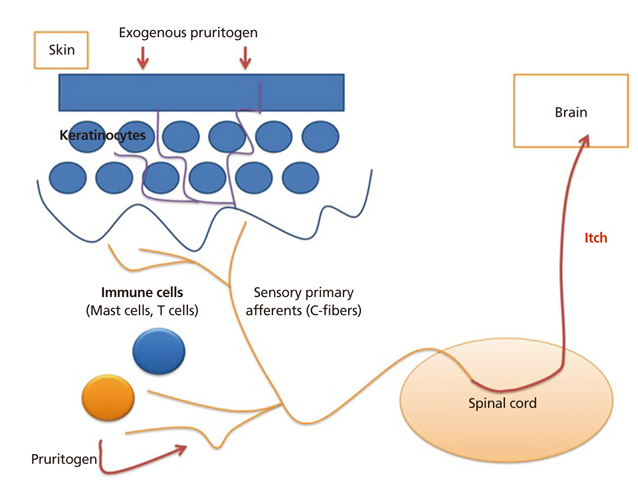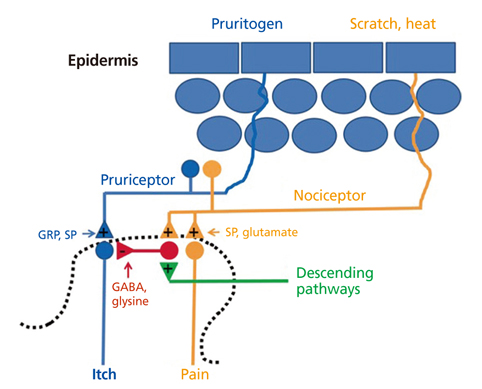J Korean Med Assoc.
2018 Nov;61(11):670-677. 10.5124/jkma.2018.61.11.670.
Pathophysiology and new treatment of itch
- Affiliations
-
- 1Department of Dermatology, Kangnam Sacred Heart Hospital, Hallym University College of Medicine, Seoul, Korea. hyeonekim@gmail.com
- KMID: 2426477
- DOI: http://doi.org/10.5124/jkma.2018.61.11.670
Abstract
- Many of the patients visit the doctors because of itching sensation. Itching is an unpleasant sensation. In the epidermal keratinocytes, various neurotransmitters and receptors are related itching. The itch signal is mainly transmitted through the lateral spinal ganglion-derived nerve fibers extending to the lower epidermis. Many mediators such as histamine are involved in the itching pathway. It can be helpful in the treatment of patients having itching sensation with a lot of new therapies from the basic medication such as antihistamines. Also, many drugs are currently under study.
MeSH Terms
Figure
Reference
-
1. Ikoma A, Steinhoff M, Stander S, Yosipovitch G, Schmelz M. The neurobiology of itch. Nat Rev Neurosci. 2006; 7:535–547.
Article2. Stander S, Schafer I, Phan NQ, Blome C, Herberger K, Heigel H, Augustin M. Prevalence of chronic pruritus in Germany: results of a cross-sectional study in a sample working population of 11,730. Dermatology. 2010; 221:229–235.
Article3. Stander S, Weisshaar E, Mettang T, Szepietowski JC, Carstens E, Ikoma A, Bergasa NV, Gieler U, Misery L, Wallengren J, Darsow U, Streit M, Metze D, Luger TA, Greaves MW, Schmelz M, Yosipovitch G, Bernhard JD. Clinical classification of itch: a position paper of the International Forum for the Study of Itch. Acta Derm Venereol. 2007; 87:291–294.
Article4. Metz M, Stander S. Chronic pruritus: pathogenesis, clinical aspects and treatment. J Eur Acad Dermatol Venereol. 2010; 24:1249–1260.5. Kamo A, Tominaga M, Kamata Y, Takamori K. Mechanisms and treatments of dry skin-induced itch. J Clin Cosmet Dermatol. 2017; 04. 24. [Epub]. DOI: 10.16966/2576-2826.114.
Article6. Yosipovitch G. The pruritus receptor unit: a target for novel therapies. J Invest Dermatol. 2007; 127:1857–1859.
Article7. MacDermot HE. The blood vessel of the human skin and their responses. Can Med Assoc J. 1927; 17:1574–1576.8. Stander S, Raap U, Weisshaar E, Schmelz M, Mettang T, Handwerker H, Luger TA. Pathogenesis of pruritus. J Dtsch Dermatol Ges. 2011; 9:456–463.
Article9. Greaves MW, Wall PD. Pathophysiology of itching. Lancet. 1996; 348:938–940.
Article10. Kalesnikoff J, Galli SJ. New developments in mast cell biology. Nat Immunol. 2008; 9:1215–1223.
Article11. Harrison S, Geppetti P. Substance p. Int J Biochem Cell Biol. 2001; 33:555–576.
Article12. Lovell CR, Burton PA, Duncan EH, Burton JL. Prostaglandins and pruritus. Br J Dermatol. 1976; 94:273–275.
Article13. Fjellner B, Hagermark O. Experimental pruritus evoked by platelet activating factor (PAF-acether) in human skin. Acta Derm Venereol. 1985; 65:409–412.14. Imamachi N, Park GH, Lee H, Anderson DJ, Simon MI, Basbaum AI, Han SK. TRPV1-expressing primary afferents generate behavioral responses to pruritogens via multiple mechanisms. Proc Natl Acad Sci U S A. 2009; 106:11330–11335.
Article15. Lumpkin EA, Caterina MJ. Mechanisms of sensory transduction in the skin. Nature. 2007; 445:858–865.
Article16. Schmelz M, Schmidt R, Bickel A, Handwerker HO, Torebjork HE. Specific C-receptors for itch in human skin. J Neurosci. 1997; 17:8003–8008.
Article17. Davidson S, Giesler GJ. The multiple pathways for itch and their interactions with pain. Trends Neurosci. 2010; 33:550–558.
Article18. Akiyama T, Iodi Carstens M, Carstens E. Transmitters and pathways mediating inhibition of spinal itch-signaling neu-rons by scratching and other counterstimuli. PLoS One. 2011; 6:e22665.
Article19. Namer B, Reeh P. Scratching an itch. Nat Neurosci. 2013; 16:117–118.
Article20. O'Donoghue M, Tharp MD. Antihistamines and their role as antipruritics. Dermatol Ther. 2005; 18:333–340.21. Adelsberg BR. Sedation and performance issues in the treatment of allergic conditions. Arch Intern Med. 1997; 157:494–500.
Article22. Grattan C, Powell S, Humphreys F;. Management and diagnostic guidelines for urticaria and angio-oedema. Br J Dermatol. 2001; 144:708–714.
Article23. Gunal AI, Ozalp G, Yoldas TK, Gunal SY, Kirciman E, Celiker H. Gabapentin therapy for pruritus in haemodialysis patients: a randomized, placebo-controlled, double-blind trial. Nephrol Dial Transplant. 2004; 19:3137–3139.
Article24. Stander S, Bockenholt B, Schurmeyer-Horst F, Weishaupt C, Heuft G, Luger TA, Schneider G. Treatment of chronic pruritus with the selective serotonin re-uptake inhibitors paroxe-tine and fluvoxamine: results of an open-labelled, two-arm proof-of-concept study. Acta Derm Venereol. 2009; 89:45–51.
Article25. Yosipovitch G, Samuel LS. Neuropathic and psychogenic itch. Dermatol Ther. 2008; 21:32–41.
Article26. Kumagai H, Ebata T, Takamori K, Muramatsu T, Nakamoto H, Suzuki H. Effect of a novel kappa-receptor agonist, nalfurafine hydrochloride, on severe itch in 337 haemodialysis patients: a phase III, randomized, double-blind, placebo-controlled study. Nephrol Dial Transplant. 2010; 25:1251–1257.
Article27. Dawn AG, Yosipovitch G. Butorphanol for treatment of intractable pruritus. J Am Acad Dermatol. 2006; 54:527–531.
Article28. Leslie TA, Greaves MW, Yosipovitch G. Current topical and systemic therapies for itch. Handb Exp Pharmacol. 2015; 226:337–356.
Article29. Beck LA, Thaci D, Hamilton JD, Graham NM, Bieber T, Rocklin R, Ming JE, Ren H, Kao R, Simpson E, Ardeleanu M, Weinstein SP, Pirozzi G, Guttman-Yassky E, Suarez-Farinas M, Hager MD, Stahl N, Yancopoulos GD, Radin AR. Dupilumab treatment in adults with moderate-to-severe atopic dermatitis. N Engl J Med. 2014; 371:130–139.
Article30. Ruzicka T, Hanifin JM, Furue M, Pulka G, Mlynarczyk I, Wollenberg A, Galus R, Etoh T, Mihara R, Yoshida H, Stewart J, Kabashima K. XCIMA Study Group. Anti-interleukin-31 receptor a antibody for atopic dermatitis. N Engl J Med. 2017; 376:826–835.
Article31. Rivard J, Lim HW. Ultraviolet phototherapy for pruritus. Dermatol Ther. 2005; 18:344–354.
Article32. Pereira U, Boulais N, Lebonvallet N, Pennec JP, Dorange G, Misery L. Mechanisms of the sensory effects of tacrolimus on the skin. Br J Dermatol. 2010; 163:70–77.
Article33. Papoiu AD, Yosipovitch G. Topical capsaicin. The fire of a ‘hot’ medicine is reignited. Expert Opin Pharmacother. 2010; 11:1359–1371.
Article34. Knotkova H, Pappagallo M, Szallasi A. Capsaicin (TRPV1 Agonist) therapy for pain relief: farewell or revival? Clin J Pain. 2008; 24:142–154.35. Knowlton WM, Palkar R, Lippoldt EK, McCoy DD, Baluch F, Chen J, McKemy DD. A sensory-labeled line for cold: TRPM8-expressing sensory neurons define the cellular basis for cold, cold pain, and cooling-mediated analgesia. J Neurosci. 2013; 33:2837–2848.
Article36. Galeotti N, Di Cesare, Mazzanti G, Bartolini A, Ghelardini C. Menthol: a natural analgesic compound. Neurosci Lett. 2002; 322:145–148.
Article37. Linte RM, Ciobanu C, Reid G, Babes A. Desensitization of cold- and menthol-sensitive rat dorsal root ganglion neurones by inflammatory mediators. Exp Brain Res. 2007; 178:89–98.
Article38. Yoo YK, Lee MS, Choi KH, Lee GT, Lee KK. The efficacy and safety test of new moisturizing cream for dry skin condition and itch relief. Korean J Aesthet Cosmetol. 2015; 13:49–57.39. Park CS. The skin barrier and moisturizer. J Skin Barrier Res. 2007; 9:11–17.
- Full Text Links
- Actions
-
Cited
- CITED
-
- Close
- Share
- Similar articles
-
- Pathophysiology, diagnosis, and management of chronic pruritus
- Itch in atopic dermatitis: from pathogenesis to treatment
- Effect of Acupuncture on Histamine Induced Itch
- Considerable Variability in the Efficacy of 8% Capsaicin Topical Patches in the Treatment of Chronic Pruritus in 3 Patients with Notalgia Paresthetica
- Clinical Character istics of Itch in Patients with Adult and Childhood Atopic Dermatitis




